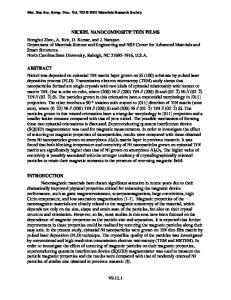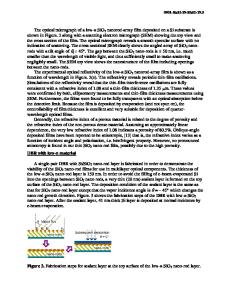Ellipsometric characterization of thin nanocomposite films with tunable refractive index for biochemical sensors
- PDF / 263,547 Bytes
- 7 Pages / 432 x 648 pts Page_size
- 42 Downloads / 321 Views
Ellipsometric characterization of thin nanocomposite films with tunable refractive index for biochemical sensors P. Petrik1, H. Egger2, S. Eiden2, E. Agocs1,3, M. Fried1, B. Pecz1, K. Kolari4, T. Aalto4 , R. Horvath1 ,D. Giannone5 1 MFA, 1121 Budapest, Konkoly Thege u. 29-33, Hungary. 2 Bayer Technology Services GmbH, 51368 Leverkusen, Germany. 3 University of Pannonia, 8200 Veszprem, Egyetem u. 10, Hungary. 4 VTT, P.O. Box 1000, FI-02044, Finland. 5 Multitel, 2, rue Pierre et Marie Curie, B-7000 Mons (Belgium). ABSTRACT Creating optical quality thin films with a high refractive index is increasingly important for waveguide sensor applications. In this study, we present optical models to measure the layer thickness, vertical and lateral homogeneity, the refractive index and the extinction coefficients of the polymer films with nanocrystal inclusions using spectroscopic ellipsometry. The optical properties can be determined in a broad wavelength range from 190 to 1700 nm. The sensitivity of spectroscopic ellipsometry allows a detailed characterization of the nanostructure of the layer, i.e. the surface roughness down to the nm scale, the interface properties, the optical density profile within the layer, and any other optical parameters that can be modeled in a proper and consistent way. In case of larger than about 50 nm particles even the particle size can be determined from the onset of depolarization due to light scattering. Besides the refractive index, the extinction coefficient, being a critical parameter for waveguiding layers, was also determined in a broad wavelength range. Using the above information from the ellipsometric models the preparation conditions can be identified. A range of samples were investigated including doctor bladed films using TiO2 nanoparticles. INTRODUCTION In order to fabricate highly sensitive biosensor chips based on polymer photonic crystal micro-cavities, two polymeric materials with a refractive index difference as large as possible are necessary. Even though polymers themselves usually do not have a very high or low refractive index, their values can be manipulated by preparing nanocomposite materials. Incorporation of high index materials into polymers is intensively studied and it has been shown that the refractive index of the original polymer material can be increased significantly. One way is to incorporate nanoparticles with a very high refractive index (like specific inorganic oxides) without losing the other desired properties of the polymers. This is also the most promising way when considering the processability of the composite materials. Therefore, the optimal particles concerning material, size, etc. is identified to maximize the refractive index while obtaining a convenient nanocomposite material. The present work is a part of the European P3SENS project [1] that aims at the design, fabrication and validation of a multichannel polymer photonic crystal-based label-free disposable
81
biosensor. The photonic chip will be based on polymer photonic crystal micro-cav
Data Loading...











